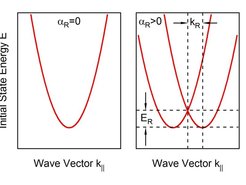
Spin-Orbit Interaction in Symmetry-Broken Environments
Spintronics devices are based on the ability to manipulate the electron spin by electric (instead of magnetic) fields. One example for such a device is the spin field effect transistor proposed by Datta and Das that is based on the Rashba effect. According to the Rashba model the spin-orbit interaction will lift the spin degeneracy of the electronic band structure in a system where space inversion symmetry is broken. Typical examples are the two-dimensional electron gases that form at the interface of semiconductor heterojunctions or at the (111) surface of, e.g., a gold single crystal. The resulting characteristic Rashba dispersion consists of two spin-polarized parabolas with effective mass m* and an offset ±kR = (αR m*)/ℏ2 away from k∥ = 0, where αR is the Rashba constant.

In real systems the size of the Rashba constant (and hence the size of the spin splitting) depends on the asymmetry of the electronic wave function in the vicinity of heavy nuclei. Hence, the size of the spin splitting is highly sensitive to the detailed atomic structure at the interface or surface. This offers the potential to control the electron spin with light, e.g. by coherently driving the atoms with strong light fields.
